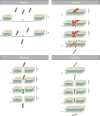Gene electrotransfer: from biophysical mechanisms to in vivo applications : Part 1- Biophysical mechanisms
- PMID: 28510029
- PMCID: PMC5430240
- DOI: 10.1007/s12551-009-0022-7
Gene electrotransfer: from biophysical mechanisms to in vivo applications : Part 1- Biophysical mechanisms
Abstract
Electropulsation is one of the nonviral methods successfully used to deliver genes into living cells in vitro and in vivo. This approach shows promise in the field of gene and cellular therapies. The present review focuses on the processes supporting gene electrotransfer in vitro. In the first part, we will report the events occurring before, during, and after pulse application in the specific field of plasmid DNA electrotransfer at the cell level. A critical discussion of the present theoretical considerations about membrane electropermeabilization and the transient structures involved in the plasmid uptake follows in a second part.
Keywords: Biophysical mechanisms; Electropermeabilization; Electroporation; Gene electrotransfer; Membranes.
Figures

Similar articles
-
Use of collagen gel as a three-dimensional in vitro model to study electropermeabilization and gene electrotransfer.J Membr Biol. 2010 Jul;236(1):87-95. doi: 10.1007/s00232-010-9280-3. Epub 2010 Jul 18. J Membr Biol. 2010. PMID: 20640849
-
Gene electrotransfer: from biophysical mechanisms to in vivo applications : Part 2 - In vivo developments and present clinical applications.Biophys Rev. 2009 Dec;1(4):185. doi: 10.1007/s12551-009-0019-2. Epub 2009 Nov 10. Biophys Rev. 2009. PMID: 28510026 Free PMC article. Review.
-
Effect of Mg ions on efficiency of gene electrotransfer and on cell electropermeabilization.Bioelectrochemistry. 2010 Oct;79(2):265-71. doi: 10.1016/j.bioelechem.2010.04.001. Epub 2010 Apr 22. Bioelectrochemistry. 2010. PMID: 20580903
-
In vitro and in vivo electric field-mediated permeabilization, gene transfer, and expression.Methods. 2004 Jun;33(2):126-35. doi: 10.1016/j.ymeth.2003.11.003. Methods. 2004. PMID: 15121167
-
Application of electroporation gene therapy: past, current, and future.Methods Mol Biol. 2008;423:3-17. doi: 10.1007/978-1-59745-194-9_1. Methods Mol Biol. 2008. PMID: 18370187 Review.
Cited by
-
The role of electrophoresis in gene electrotransfer.J Membr Biol. 2010 Jul;236(1):75-9. doi: 10.1007/s00232-010-9276-z. Epub 2010 Jul 18. J Membr Biol. 2010. PMID: 20640850
-
Gene Electrotransfer: A Mechanistic Perspective.Curr Gene Ther. 2016;16(2):98-129. doi: 10.2174/1566523216666160331130040. Curr Gene Ther. 2016. PMID: 27029943 Free PMC article. Review.
-
Gene Immunotherapy of Colon Carcinoma with IL-2 and IL-12 Using Gene Electrotransfer.Int J Mol Sci. 2023 Aug 17;24(16):12900. doi: 10.3390/ijms241612900. Int J Mol Sci. 2023. PMID: 37629081 Free PMC article.
References
-
- Bandyopadhyay S, Tarek M, Klein ML. Molecular dynamics study of lipid-DNA complexes. J Phys Chem B. 1999;103:10075–10080. doi: 10.1021/jp9927496. - DOI
-
- Barnett A, Weaver JC. Electroporation: a unified, quantitative theory of reversible electrical breakdown and rupture. Bioelectrochem Bioenerg. 1991;25:163182. doi: 10.1016/0302-4598(91)87001-W. - DOI
-
- Blackburn GM, Gait MJ. Nucleic acids in chemistry and biology. Oxford: Oxford University Press; 1996.
Publication types
LinkOut - more resources
Full Text Sources

